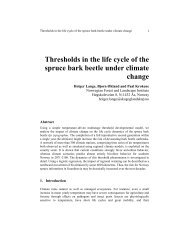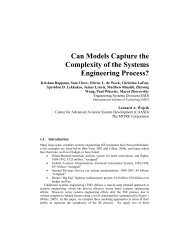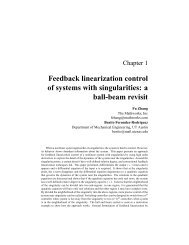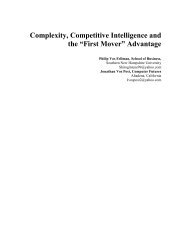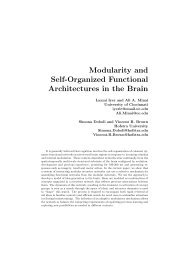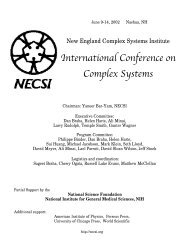the Future Map Methodology - New England Complex Systems ...
the Future Map Methodology - New England Complex Systems ...
the Future Map Methodology - New England Complex Systems ...
You also want an ePaper? Increase the reach of your titles
YUMPU automatically turns print PDFs into web optimized ePapers that Google loves.
4<br />
1. Create a boundary-less, systemic, holistic view of <strong>the</strong> future security<br />
environment based on broad inter-domain, inter-agency, and when possible,<br />
global expertise.<br />
2. Bridge <strong>the</strong> methodological gap between future-related techniques and processes<br />
and established “core” organizational tools and processes, thus making future<br />
preparedness a daily activity linked to established reporting and measurement<br />
tools such as organizational scorecards. [Kaplan and Norton, 1996.]<br />
Organizations need to track not only <strong>the</strong> external environment, but also <strong>the</strong>ir<br />
internal preparedness progress.<br />
3. Connect four elements – future exploration, early warning, communication, and<br />
use of information about <strong>the</strong> future as parts of one comprehensive system, a<br />
unique depository of all future-related knowledge, as well as a real-time, shared<br />
space for exchanges, analyses, debates and learning.<br />
4. Integrate both long- and short-term preparedness perspectives – be reactive<br />
enough to offer real time intelligence along with strategic foresight, to avoid <strong>the</strong><br />
competition for decision makers attention between <strong>the</strong>ir daily needs and <strong>the</strong> “big<br />
picture,” recognizing that both are essential to strategic success.<br />
5. Ensure a highly intuitive visual interface, in order to be able to communicate <strong>the</strong><br />
situation and key messages quickly, and speak <strong>the</strong> language of decision makers<br />
in a way that conveys highly strategic analysis along with pure facts.<br />
Where can we look for inspiration in designing such a tool? Take <strong>the</strong> example of <strong>the</strong><br />
Airborne Warning and Control System (AWACS). What makes it so valuable?<br />
Integrating on one screen and tracking in real time <strong>the</strong> battlefield and <strong>the</strong> movements of<br />
own and hostile forces, <strong>the</strong> AWACS creates a transparent decision environment, in which<br />
both staff and field participants can contribute and learn. As <strong>the</strong> result, <strong>the</strong> AWACS<br />
allows to conduct joint, network-centric warfare, linking “sensors, decision makers and<br />
shooters to achieve shared awareness,” [Alberts, quoted from Fuerth, 2006.]<br />
We need tools that create “shared awareness” of <strong>the</strong> complex and continuously changing<br />
global political and security environment and that extend this awareness “as far into <strong>the</strong><br />
future as possible” [Fuerth, 2005.] Without such tools it is hardly possible for <strong>the</strong> new<br />
decision making culture to take hold.<br />
5. The Event Field<br />
How can we assemble a shared picture of <strong>the</strong> future from a multitude of facts and<br />
opinions? How can we present <strong>the</strong> future in a way that facilitates decision-making? How<br />
can we get <strong>the</strong> maximum number of people within and outside of <strong>the</strong> organization<br />
involved into <strong>the</strong> scanning of <strong>the</strong> global environment? How can we learn to continuously<br />
question our assumptions and conclusions? How can we make <strong>the</strong> information collection<br />
and information assessment processes work toge<strong>the</strong>r as one?<br />
All future scenarios, objectives, decisions, and warning signals are <strong>the</strong> events that we<br />
anticipate. Using an anticipated event as <strong>the</strong> “common denominator,” we can recreate our<br />
future environment, both short- and long-term. We believe that we need to put in front of<br />
decision makers <strong>the</strong> field of anticipated events with which <strong>the</strong> organization will have to<br />
deal in <strong>the</strong> future. This Event Field is <strong>the</strong> product of our collective anticipation; it is <strong>the</strong><br />
picture that appears on our collective future “radar screen.” Our goal is to construct <strong>the</strong><br />
organization’s Event Field and <strong>the</strong>n continuously question and clarify this picture of <strong>the</strong><br />
future using all means available.



